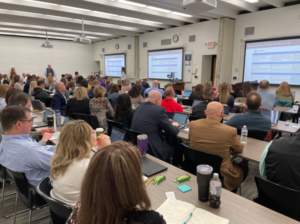8 Ways Blended Learning Changes the Game

Christine Byrd
Despite having been raised by two teachers and working for an ed tech company, I knew that sending my oldest off to kindergarten this year would be an education for me.
Volunteering in his class, I was blown away by the range of skills these five-year-olds brought. Some were reading books and writing in complete sentences before the first day, while others were still learning the alphabet.
How could any teacher manage such disparity in her daily lessons, much less challenge the advanced kids while nurturing those who needed some extra help? Obviously this is where “self-paced” and “individualized” learning get their appeal.
In the classroom, I got my first real-world experience with the difference between self-paced learning in a blended learning form compared with its pre-digital form – workbooks and worksheets. And what a world of difference they are.
Traditional Self-paced Program for Reading
The kindergarteners were divided into groups by reading level for bi-weekly Response to Instruction (RTI) reading lessons. The students rotate in groups from a writing lesson with the teacher to a reading comprehension session with volunteer parents, like me. The reading comprehension program is self-paced, with a dozen color-coded booklets and corresponding worksheets each child must complete. Every child is working on a different workbook (there’s only one copy of each in the classroom) and then they trade off as they finish, progressing at their own pace
Digital Self-paced Program for Math
For math the entire class uses the online game-based program ST Math weekly in the computer lab and occasionally in rotation model in the classroom with a half dozen ipads and computers. (Full disclosure, I work for the nonprofit that creates ST Math and let my son play the games at home for months before he started at school.)
How Blended Learning Changes the Game
1. Truly self-paced
The self-paced reading comprehension system requires an adult to keep track of who’s completed which workbook and make sure they are trading off a new one. It’s not an exact science, nor a very efficient one. A child may wait a few minutes for us to figure out which workbook he still needs to complete and retrieve it from another student.
With digital tools, this isn’t an issue. The program can seamlessly and fluidly advance the child to the next problem or a level of difficulty
2. Feedback is immediate
After class, we correct the worksheets the students worked on (some completed two, some completed seven, each working at their own pace). Unfortunately, there’s no chance for me to tell Madison that the picture of a baby flower is a “bud” not, as she wrote, a “bit.” So she missed an opportunity to learn a new vocabulary word.
With the online program like ST Math, if a student selects four blocks as the answer to what one block plus two blocks equals, the program immediately shows that she’s one short. This helps learning occur.
3. Teachers can be more efficient
Another parent and I correct the worksheets. Everyone completed different workbooks that day, so there is no single answer key to check them against. It’s quick and easy, but this kind of mundane task is a time-suck for a teacher’s valuable time. Except for one reason…
4. Identifying struggling students is easier
When I correct the papers, I notice that certain students are struggling significantly more than others. That’s information that the teacher needs – and preferably during the course of the lesson, not after class.
Good digital tools give teachers access to reports about how the students are progressing overall, and if there are any struggling right that moment that need special attention.
5. Digital is more natural
With the reading groups, toggling between the workbooks with the questions and the worksheets where they write their answers presents a surprising array of challenges for the kinders, who seem to write the answers on the wrong lines or in the wrong sections, even after a few weeks of practice.
I watched a class of 30 kindergarteners simultaneously sit down and start clicking away in ST Math the first day after watching an intro video. By comparison, this seemed so much simpler.
6. “There’s no achievement gap in videogames”
There are a number of ELL students in my son’s class and one or two with learning challenges. One student in particular seems to constantly struggle with following directions in class. It seems there are too many distractions for him to focus on the teacher in front of him or the task that’s literally at hand. But I noticed he was unusually focused in in the computer lab, more in the zone with ST Math than I’ve ever seen him. Watching this student brought to mind my colleague Dr. Art McCoy’s favorite saying: “There’s no achievement gap in video games.”
7. Games are fun
Not all digital tools are game-based, but ST Math is, and for comparison, this is a lot more fun than a seemingly endless stream of worksheets. Words cannot express the disappointment on the face of a child when I told him that even though he’d completed all 12 of the purple reading comprehension workbooks, he had dozens more workbooks in other colors to complete.
This isn’t an issue with video games, where kids are competing with themselves to advance to the next level. In ST Math, for example, students are solving problems to help JiJi the penguin cross the screen and get home. This paradigm is as old as Mario Brothers, and intrinsically compelling.
When my son used ST Math at home, I remember him gleefully exclaiming, “Yes! 100%” when he completed a level with no errors. Work is more fun when it’s a game.
8. Failure isn’t failure with video games
I have to admit, I have never been a gamer. But even I understand that there is no stigma with losing in video games. You just play again, challenging yourself to make it further next time. When my son played ST Math at home, he rarely started with “Yes! 100%” He usually started with an equally gleeful “Yes! 18%” followed a few minutes later by “Yes! 40%.” Of course, in the context of schoolwork, those sound like failing grades to me. But it doesn’t carry that same meaning for a five-year-old nor does it with gaming. He was excited to be, essentially, failing a level and getting a chance to play it again for a higher score. ST Math is all about learning by doing, and embracing the failure as an essential part of the learning process.
But the red ink on those worksheets with 2 out of 6 correct answers? I haven’t seen one of the kids react to that yet, but I’m afraid it would still feel something like failure.
My few months of volunteering in my son’s class have given me deeper insight into education than my previous 10 years working in industry. And one takeaway is that if you have a great teacher and you want her to spend valuable time with your student, I hope she’s got some powerful digital learning tools at her disposal.
This blog is part of our Smart Parents Series in partnership with the Nellie Mae Education Foundation. We would love to have your voice in the Smart Parents conversations. To contribute a blog, ask a question, or for more information, email Bonnie Lathram with the subject “Smart Parents.” For more information about the project see Parents, Tell Your Story: How You Empower Student Learning as well as other blogs:
- Parents as Chief Advocates
- 3 Ways Parents Can Spot Student-Centered Learning
- I Need A Learning Sherpa
 Christine Byrd is communications manager for the education nonprofit MIND Research Institute. She shares the beauty of math with her sons through everyday activities like baking, bike-riding and building blocks. Follow her on Twitter @cabyrdie.
Christine Byrd is communications manager for the education nonprofit MIND Research Institute. She shares the beauty of math with her sons through everyday activities like baking, bike-riding and building blocks. Follow her on Twitter @cabyrdie.







0 Comments
Leave a Comment
Your email address will not be published. All fields are required.